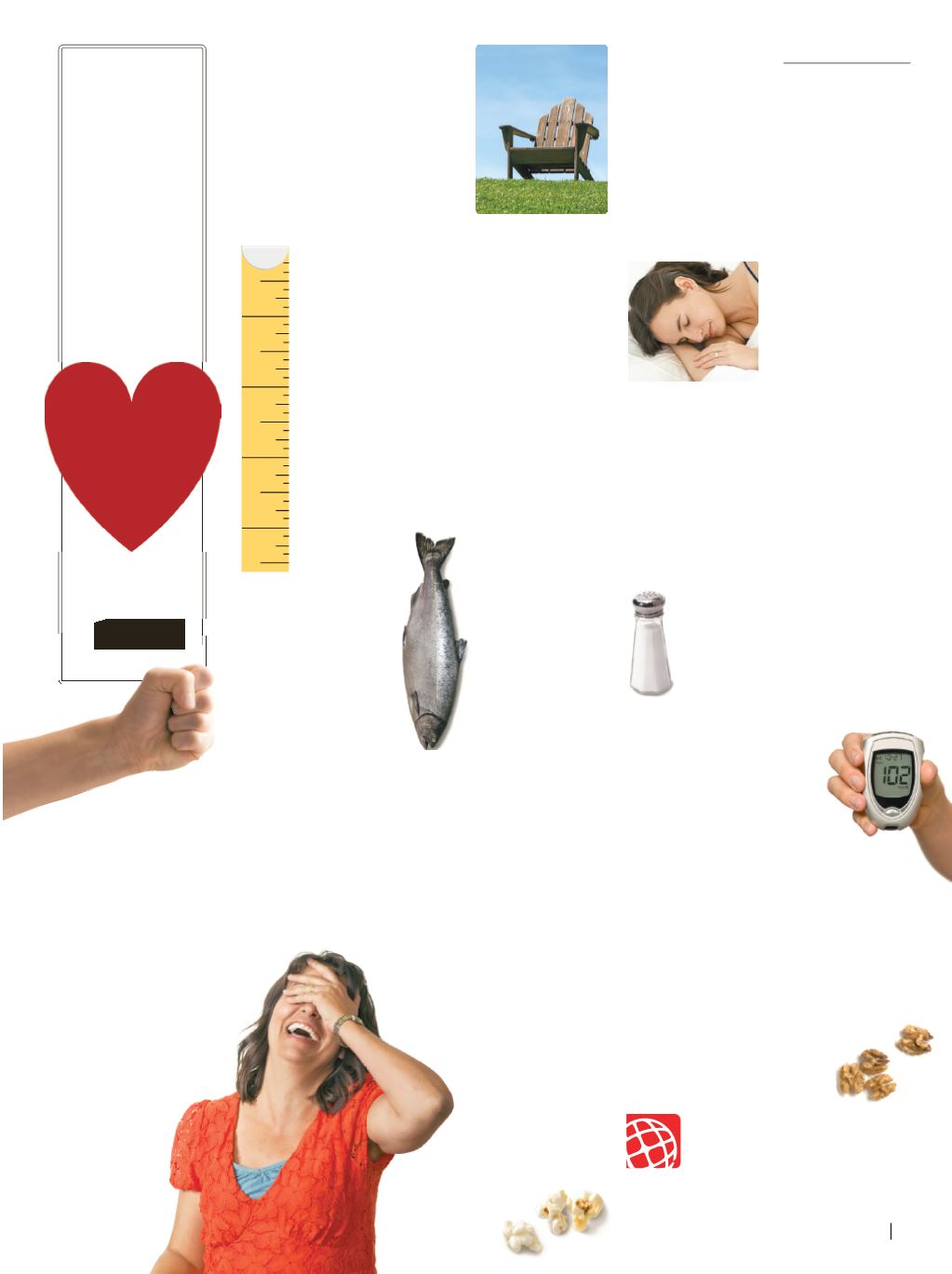
TIPS
Heart-
healthy
15
FOR A
20
15
A N D T H E
B E AT
G O E S O N
1
Chill out.
Stress can lead to
high blood pressure, inactiv-
ity, overeating and smoking—all
of which are hard on your heart.
For healthy stress relief, spend
at least 15 minutes a day
engaged in a hobby or other
activity that makes you happy.
2
Measure
up.
Excess
body weight,
particularly
in your belly,
can strain your
heart. If you’re
a woman, work
to whittle down
your middle if
it’s more than
35 inches
around. For
men, more
than 40 inches
is a red flag.
1 2 3 4
3
Make a fist.
Too
much of even the
best foods can make
you pack on pounds.
To control portions and
avoid overeating, down-
size your dinner plates.
Then keep individual
servings to between ½
and 1 cup, or about the
size of a woman’s fist.
4
Yuk it up.
Laughter lowers stress, reduces
inflammation in the arteries and even in-
creases HDL—the good cholesterol. So read a
few jokes or watch a funny movie and LOL!
6
Put on the dog.
Spending time with
a four-footed friend may
lower your blood pressure
and your heart rate. If your
BFF is a canine, you’ll be
out walking more—and
making new social con-
nections. And no matter
its species, a pet can fill
your heart with joy.
7
Go fish.
The omega-3
fatty acids that
help protect your
heart come in some
delicious pack-
ages: Think salmon,
sardines or lake
trout. Twice a
week, grill or
bake a 3.5-ounce
serving, squeeze on
some lemon juice
and enjoy!
8
Kick butts once and
for all.
Did you know
smoking can rob you of
HDL cholesterol—the
kind that helps protect
your heart? It’s never
too late to try a smoking
cessation program. Your
doctor can help.
10
Walk on by.
Brisk walks help keep
tickers in tune as effectively as
jogging. The more steps you take each
week, the greater the health benefits.
Shoot for a total of 30 minutes on most
days. (You can break it up into three
10-minute walks.)
11
Sleep tight.
Getting
enough shut-eye is
important to cardio-
vascular health. For
most adults, that
means sleeping six to eight hours each
and every night.
12
Do the math.
High cholesterol,
high triglycerides and high blood
pressure add up to an increased risk
for heart disease. So get your numbers
checked—and follow your doctor’s advice
on lowering any that are too high.
13
Shake the salt.
Most of
the sodium that’s rais-
ing Americans’ blood pressure
comes from processed foods. So
read food packages, and choose
those labeled low-sodium.
14
Take control.
If you
have type 2 diabe-
tes, work with your health
care team to control these
risk factors for heart disease:
obesity, high blood cholesterol, high
blood pressure and high blood sugar.
15
Be a little nutty.
A handful of un-
salted nuts—especially walnuts,
which help lower the body’s production
of LDL (the bad cholesterol)—makes
a heart-healthy snack. Since nuts are
high in calories, keep portions small
(about 14 halves for walnuts).
D I S C O V E R M O R E
Need a heart-healthy meal
plan to control diabetes? Our
registered dietitians can help. Call
(208) 625-5500
.
5
Be a social butterfly.
Lonely people are at
increased risk for high
blood pressure. To lower
yours, make some new
connections: Join a
book club, volun-
teer at a senior
center or start
a neighbor-
hood hiking
group.
9
Get grainy.
Swapping
refined grains for whole
grains may lower your
risk of heart disease
by roughly 25
percent. There are
plenty of delicious,
easy-to-prepare options,
from whole-wheat pasta to
unsalted popcorn.
KH . ORG
13
HEART HEALTH


